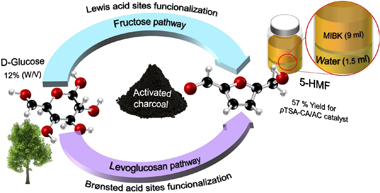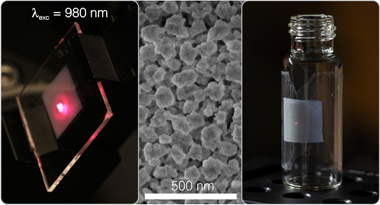Scientific Papers in SCI
2021
2021
Reactividad de Sólidos
Tuning the excitation wavelength of luminescent Mn2+-doped ZnSxSe1-x obtained by mechanically induced self-sustaining reaction
Aviles, MA; Gotor, FJOptical Materials, 117 (2021) 111121
Show abstract ▽
Mn2+-doped ZnSxSe1-x solid solution samples (Mn:ZnSxSe1-x) were synthesized by the mechanochemical process denoted as mechanically-induced self-sustaining reaction from Mn/Zn/S/Se powder elemental mixtures. The samples were characterized by X-ray diffraction, scanning electron microscopy, diffuse reflectance UV-Vis spectroscopy and emission and excitation photoluminescence measurements. The band-gap energy of samples was controlled by changing the stoichiometry, x, of the solid solution. All samples showed the characteristic Mn2+ 4T1-6A1 emission at -588 nm when exciting the host material, so it was possible to tune the excitation wavelength from 349 nm to 467 nm. However, an efficiency loss was observed with increasing Se content, probably due to the overlap between the absorption and emission spectra that induced self-absorption and emission quenching.
July, 2021 | DOI: 10.1016/j.optmat.2021.111121
Archeometric characterization (physical-chemical and microstructural) of tiles in the Mudejar Palace of the Royal Alcazar of Seville using non-invasive quantitative chemical methods
Perez-Rodriguez, JL; Robador, MD; Castaing, J; de Viguerie, L; Garrote, MA; Pleguezuelo, ABoletin de la Sociedad Española de Ceramica y Vidrio, 60 (2021) 211-228
Show abstract ▽
The Palaces in the Alcazar of Seville, Spain, are famous for their ceramic decoration. The technique of tessellation was used extensively in all rooms in the Mudejar Palace, dated in the fourteenth century. These glazed ceramics have been analysed in situ using noninvasive quantitative chemical methods of X-ray fluorescence and diffraction (XRF and XRD). Micro-samples were taken to prepare cross-sections and analysed by optical and electronic microscopy. The composition of these ceramics, their manufacturing technique and the time of application in the different areas of the Palace have been characterized in this work. Five colours have been found in the glazed ceramics: green, black, molasses, white and blue. Fe, Co, Cu, Mn and Sn are the main chemical elements responsible for the colour of the glass phase of these ceramics. Wollastonite, quartz, bustamite and feldspars inclusions have been found in the glass phase. Casiterite and Malayaite have been also characterized by XRD. The ceramic paste used for manufacturing was calcic and was heated at about 900 degrees C. Thenardite, gypsum, sodium chloride and nitrogen compounds have been characterized in the ceramic and are responsible for their alteration. The information obtained in the 24 zones studied shows that there is no homogeneity in the ceramics due to the different times in which the tiles were placed and the restorations carried out over time. There are 3 main groups of ceramics: a) probably from 14th century, b), probably from 15-16th centuries and c) from 19-20th centuries and recent restorations.
July, 2021 | DOI: 10.1016/j.bsecv.2020.03.001
Química de Superficies y Catálisis
Dehydration of glucose to 5-Hydroxymethlyfurfural on bifunctional carbon catalysts
Bounoukta, CE; Megias-Sayago, C; Ammari, F; Ivanova, S; Monzon, A; Centeno, MA; Odriozola, JAApplied Catalysis B-Environmental, 286 (2021) 119938
Show abstract ▽

The proposed study tries to reply on one important question concerning glucose dehydration: What is the role of bare or tandem Lewis/Bronsted acid sites in the reaction and which are better? A series of mono and bifunctional catalyst are designed and screened for the glucose dehydration reaction. The results clearly reveal that catalyst activity is a function of catalyst composition. The presence of Lewis sites the reaction toward first step isomerization, while the Brunsted acid dehydrate directly glucose to HMF via levoglucosane intermediate. This study proposed also a kinetic modelling of the included reactions and their contrast with the empirical observations.
June, 2021 | DOI: 10.1016/j.apcatb.2021.119938
Materiales Ópticos Multifuncionales - Materiales Coloidales
Highly Versatile Upconverting Oxyfluoride-Based Nanophosphor Films
Ngo, TT; Cabello-Olmo, E; Arroyo, E; Becerro, AI; Ocana, M; Lozano, G; Miguez, HACS Applied Materials & Interfaces, 13 (2021) 30051-30060
Show abstract ▽

Fluoride-based compounds doped with rare-earth cations are the preferred choice of materials to achieve efficient upconversion, of interest for a plethora of applications ranging from bioimaging to energy harvesting. Herein, we demonstrate a simple route to fabricate bright upconverting films that are transparent, self-standing, flexible, and emit different colors. Starting from the solvothermal synthesis of uniform and colloidally stable yttrium fluoride nanoparticles doped with Yb3+ and Er3+, Ho3+, or Tm3+, we find the experimental conditions to process the nanophosphors as optical quality films of controlled thickness between few hundreds of nanometers and several micrometers. A thorough analysis of both structural and photophysical properties of films annealed at different temperatures reveals a tradeoff between the oxidation of the matrix, which transitions through an oxyfluoride crystal phase, and the efficiency of the upconversion photoluminescence process. It represents a significant step forward in the understanding of the fundamental properties of upconverting materials and can be leveraged for the optimization of upconversion systems in general. We prove bright multicolor upconversion photoluminescence in oxyfluoride-based phosphor transparent films upon excitation with a 980 nm laser for both rigid and flexible versions of the layers, being possible to use the latter to coat surfaces of arbitrary shape. Our results pave the way toward the development of upconverting coatings that can be conveniently integrated in applications that demand a large degree of versatility.
June, 2021 | DOI: 10.1021/acsami.1c07012
Reactividad de Sólidos
Paving the Way to Establish Protocols: Modeling and Predicting Mechanochemical Reactions
Gil-Gonzalez, E; Perez-Maqueda, LA; Sanchez-Jimenez, PE; Perejon, AJournal of Physical Chemistry Letters, 12 (2021) 5540-5546
Show abstract ▽
Parametrization of mechanochemical reactions, or relating the evolution of the reaction progress to the supplied input power, is required both to establish protocols and to gain insight into mechanochemical reactions. Thus, results could be compared, replicated, or scaled up even under different milling conditions, enlarging the domains of application of mechanochemistry. Here, we propose a procedure that allows the parametrization of mechanochemical reactions as a function of the supplied input power from the direct analysis of the milling experiments in a model-free approach, where neither the kinetic model function nor the rate constant equation are previously assumed. This procedure has been successfully tested with the mechanochemical reaction of CH3NH3PbCl3, enabling the possibility to make predictions regardless of the milling device as well as gaining insight into the reaction dynamic. This methodology can work for any other mechanical reaction and definitely paves the way to establish mechanochemistry as a standard synthetic procedure.
June, 2021 | DOI: 10.1021/acs.jpclett.1c01472
- ‹ previous
- 73 of 410
- next ›














